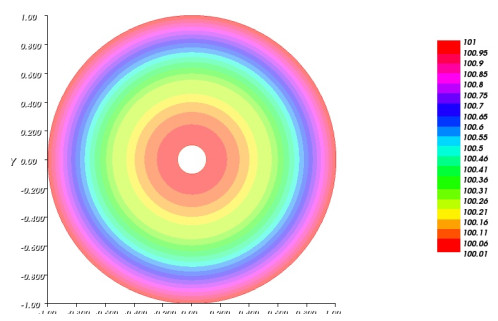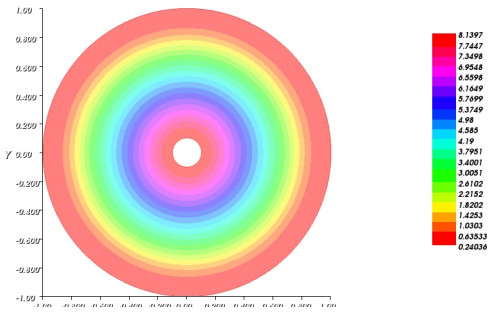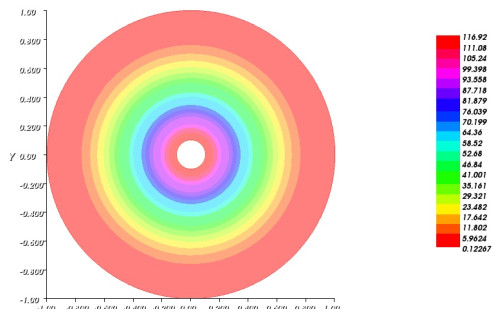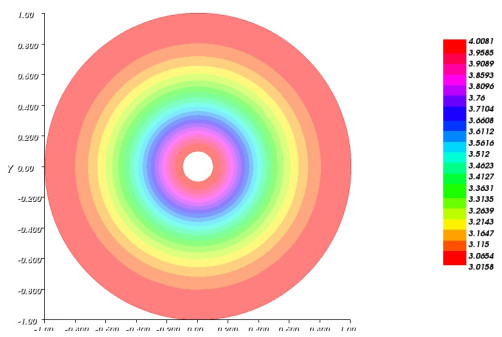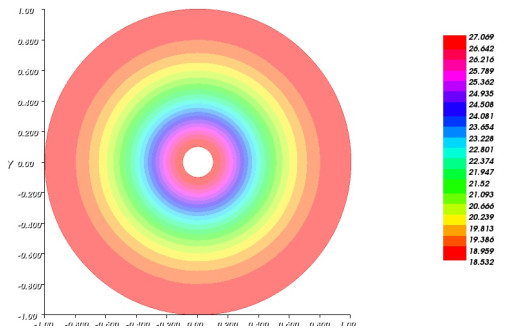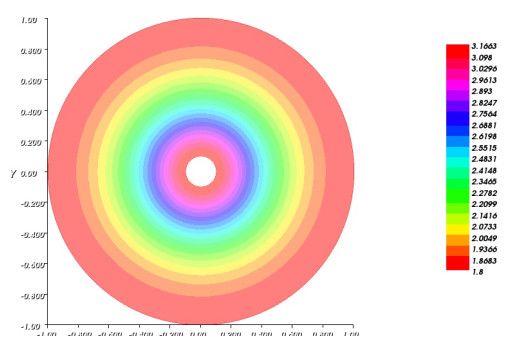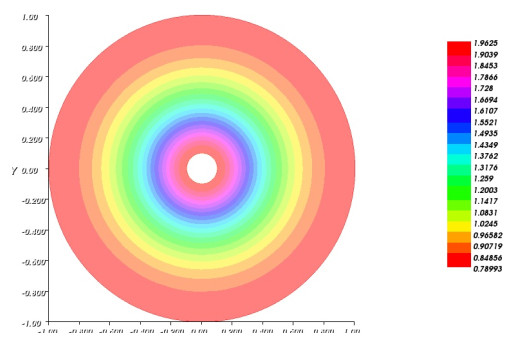1.
Introduction
Taxis is understood as the motion of an organism towards or away from an external stimulus. In particular when the stimulus is a chemical, it is called chemotaxis. It seems natural to address the problem of driving the motion of the organism by modifying or applying a chemical gradient. In this paper we have in mind a process in which chemotaxis takes place, the tumor angiogenesis. However, we could extend the same idea for other biological processes where the chemotaxis is involved.
Tumor angiogenesis starts when, as a response to nutrient deprivation, cancer cells secrete a chemical factor known as Tumor Angiogenic Factors (TAF)s. (TAF)s diffuse in the extracellular matrix and activate endothelial cells which migrate, via chemotaxis, towards the source of TAF i.e., the tumor. When endothelial cells reach the tumor more nutrients are supplied to the tumor which grows further. See for instance [16] for additional details.
It is clear that angiogenesis is a crucial step in the development of the tumor. Therefore, if we act in the (TAF)s molecules or if we modify the response of the endothelial cells to the (TAF)s molecules we may either reduce angiogenesis or avoid it.
In this paper we consider two variables u, the density of endothelial cells and z the concentration of anti-angiogenic drug that modifies the sensitivity of a chemical gradient v (TAF) and the growth of the endothelial cells. We also assume that u, z and v are defined in a bounded domain Ω⊂IR3. Here we are interested in the minimum of the functional defined by
where a and b are positive parameters and (u,z) is a solution of the nonlinear differential equation
and z∈Uad where
The functional has two terms; the first term refers to the amount of endothelial cells at the final stage and the second one can be seen as the cost of the drug over the time.
Minimizing a functional (1.1), subject to a differential problem (1.2) and a convex constraint, z∈Uad, is a problem of the optimal control theory. It is classical in this theory to call u state variable and to call z control variable, because it controls the state through the equation. The nonlinearity of (1.2) leads that the minimal problem is out of the convex framework. We will apply a generalization of the Lagrange multipliers theorem to obtain the optimality system which provides the necessary condition for the solution. This method, called Dubovitskii-Milyutin formalism (see [7]) has been mostly applied to ordinary differential equations (see [13]). In [6] it is applied to a linear partial differential problem with the feature that it is non well-posed. The optimal problem we study in this paper have the difficulty of the nonlinearity of the partial differential equation and the control constraint z∈Uad which has empty interior in L2(Q).
The formalism gives an optimality system constituted by two partial differential coupled equations, one is the state equation given in (1.2) and the other one is a linear equation for the adjoint variable, and a condition for the optimal control given by a projection operator. We will prove the uniqueness of solution of the optimality system for T small enough and this turns out the uniqueness of solution of the optimal problem.
The chemotaxis is described in (1.2) by the term div(V(u)α(z)∇v). A similar description of the chemotaxis was introduced in [12] where there is an additional equation for v. Since, the minimal system proposed in [12] could generate singularities in finite time (see [11]) then to avoid the singularities it is proposed a model with a bounded drift term in [9]. In the case of angiogenesis, one of the first continuous models related to angiogenesis is introduced in [1]. A similar model to the one in the paper, without the variable z but with an additional equation for chemoattractant is given in [4]. The case of a therapy z satisfying an additional parabolic equation is considered in [17] and [5].
The structure of the paper is as follows. In Section 2 we prove the existence of a unique weak solution of (1.2), global in time and positive, fixed z. The optimal control problem, the existence of the optimal control, its characterization and the uniqueness when T is small enough are studied in Section 3. In Section 4 we show some numerical simulations to illustrate the theoretical results.
2.
Global existence and uniqueness for the equation
Let Ω⊂IRN be a regular bounded domain and T>0 a fixed number. We will denote Q=Ω×(0,T) and Γ=∂Ω×(0,T). In this paper, we consider the problem
Here, v∈W2,∞(Ω) is a known function, z∈L2(Q), and u0∈L2(Ω). The function V:[0,+∞)→[0,+∞) verify V(0)=0 and V∈C2([0,∞))∩L∞([0,∞)). If it is needed we will extend this function by zero for negative values. The functions α:[0,+∞)→[0,+∞) is in W1,∞([0,+∞)) and β:[0,+∞)×[0,+∞)→[0,+∞) is in C2([0,∞))∩L∞([0,∞)). We would like to point out here that the main difficulty of the problem is that z is not defined on ∂Ω.
Let T>0 and X is a Banach space, we define the space Lp(0,T;X) of equivalence classes of measurable functions u:I→X such that t∈(0,T)→‖u‖X belongs to Lp(I) which is a Banach space for the norm
For instance, we will use
The definition of a weak solution for the problem is
Definition 2.1. We say that u is a weak solution of (1.2) if the following conditions are verified
1) u∈W(0,T) where
2) ∀w∈C1([0,T]×ˉΩ):w(T,x)=0,∀x∈ˉΩ, it holds
Theorem 2.2. If u0∈L∞(Ω), u0≥0, then there is a unique positive global weak solution to the problem (1.2) that also satisfies
Proof. We denote by
and we define the mapping S:BR→L2(0,T;L2(Ω)) such that for each ˉu∈BR, S(ˉu)=u is the weak solution of the linear problem
where
We will prove the existence of a fixed point for S which is a weak solution of a truncated nonlinear problem. After that we will justify that the weak solution to the truncated problem is a solution of (1.2). At the end we will show the uniqueness of weak solution of (1.2).
Step1_ First of all we show that the operator S is well defined. The existence and the uniqueness of the weak solution for the linear problem (2.3) follow from [14]. More precisely, by [14], Theorem 6.39] the problem (see [14], p. 136])
(where fi=−V(ˉu)α(z)∂iv and c0(x,t)=β(z,v)−Tk(ˉu) in (2.3) and ν=(ν1,..,νN) is the outward normal to Ω), has a unique weak solution i.e. u∈L2(0,T;H1(Ω))∩L∞(0,T;L2(Ω)) such that
for each w∈C1([0,T]×ˉΩ) such that w(T,x)=0,∀x∈Ω. Note that, if ut∈L2(0,T;(H1(Ω))′) then the previous definition it is exactly the one given in Definition (2.1). Therefore we should show that ut∈L2(0,T;(H1(Ω)′).
where ⟨⋅,⋅⟩ stands for the duality pairing between (H1(Ω))′ and H1(Ω). Therefore
and
i.e., u_t\in L^2(0, T; (H^1({\Omega}))') . Hence, S is well defined.
In what follows we will apply the Schauder fixed point theorem to get the existence of a fixed point for S in B_R .
\underline {{\rm{Step 2}}} We claim that there exists R > 0 and T > 0 such that S(B_R)\subset B_R . In fact, multiplying the equation of (2.3) by u and integrating in {\Omega} , it results
Thus for y(t) = { }{\int_{\Omega} u^2} we obtain the problem
for some positive constants a, \, \, b . Consequently,
We can choose any R > y(0) = \Vert u_0\Vert_2 and determine T > 0 such that
and
if we take R > 1 and T < 1 . So, for R\geq \Vert u_0\Vert_2+1 there exists T < 1 such that S(B_R)\subset B_R .
On the other hand, taking into account that
we can choose R , determine T and integrate the inequality on the interval (0, T) to obtain
Consequently, \Vert u\Vert_{L^2(H^1)} is bounded.
\underline {{\rm{Step}}\; 3} We claim that S is a continuous mapping. We will prove that
with \Phi(k, s)\to 0 when s\to 0 for each fixed k , and T as in Step 2. If we denote u_1 = S(\bar u_1) and u_2 = S(\bar u_2) , it holds
and taking w = u_1-u_2 = S(\bar u_1)-S(\bar u_2) , we have
On multiplying the previous inequality by w and integrating on {\Omega} we obtain
Next, we provide a bound to the terms in the right hand side of (2.9)
The Sobolev embedding H^1({\Omega})\hookrightarrow L^6({\Omega}) together with the estimate u_2\in L^2(0, T; H^1({\Omega})) implies that u_2 \in L^2 (0, T; L^6 (\Omega)) . On the other hand if we apply the Hölder inequality with exponents 3 and 3/2 to the last term of the above inequality we obtain
Using the interpolation inequality,
and, thus
Then (2.9) becomes
We denote by y(t) = \int_{\Omega} w(x, t)^2\, dx . Since y(0) = 0 it follows from (2.10) that
By the Hölder inequality it holds
Since
it results from (2.11),
Integrating on (0, T) , we obtain
which proves the desired continuity.
\underline {{\rm{Step}}\; 4} We claim that S is a compact mapping in L^2 (Q) . We know that for each \overline u \in B_R S(\overline u) = u is bounded in L^2 (0, T; H^1 (\Omega)) and S(\overline u)_t = u_t is bounded in L^2 (0, T; (H^1(\Omega))') (see (2.7) and (2.5)) then by the Lions-Aubin Lemma (see for instance [18]) S(B_R) is embedded compactly in L^2 (0, T; L^2 (\Omega)) .
\underline {{\rm{Step}}\; 5} By the Schauder Theorem we have a solution to the problem
We will prove that any solution of (2.13) is nonnegative. Let u^- = \min (u, 0) . Taking u^- as a test function in the above equation we obtain
Integrating on the space variable infer
Therefore, u^- (t) = 0 a.e. in \Omega .
\underline {{\rm{Step}}\; 6} We prove that a solution to (2.3) satisfies u\in L^\infty(0, T; L^\infty({\Omega})) independently of the k , as a consequence a solution of (2.13) is a solution to (1.2) for k sufficiently large. We multiply (2.3) by pT_k(u)^{p-1} for p\geq 2 , a cut off function that approximate to pu^{p-1} (see for instance [3], p. 1196]) to get
Since V(0) = 0 and V is a Lipschitz function then,
Adding on both sides of the above inequality \int_\Omega T_k(u)^p we deduce that
At this point we will provide a bound for \int_\Omega u^p . We claim that for any \epsilon > 0
Next lines are devoted to the proof of the above inequality. Let \overline z = \frac{1}{|\Omega|} \int_\Omega z . We know that
On the other hand, by the Hölder inequality and the Poincare-Wintinger inequality we have
Therefore if we take z = T_k(u)^{p/2} the claim easily follows. By (2.15) we get from (2.14) that
For any 0\leq t\leq T < T_{max} , where T_{max} stand for the maximal existence time, the above inequality asserts
Let us define
From (2.16), by a recursive procedure, we have
In particular, for p = 2^j we deduce
where s_j = \sum_{i = 0}^j 2^{-i} . Taking into account that
Therefore we can take k\rightarrow +\infty to get
Since
we can take j \rightarrow \infty to conclude that
\underline {{\rm{Step}}\; 7} Uniqueness of solution for (1.2). Let be two solutions of (1.2), u_1, \, \, u_2 , and we take w = u_1 -u_2 . We can argue as in Step 3 to obtain
for some a' > 0 . By the boundedness of u_1 +u_2 we easily get the result by the Gronwall Lemma.
3.
The optimal control problem
In this section we are interested in the minimum of the functional
defined by
a and b are positive parameters and (u, z) has to be a solution of the nonlinear differential equation
and besides, we claim z that
The function u represents the endothelial cell (EC) density, the initial data u_0\in L^{\infty}(\Omega) , u_0\ge 0 and not identically zero, means that the angiogenesis process has already begun, the TAF concentration is given by v and it is known in the equation and the concentration of the anti-angiogenic drug is represented by z which is the control function. Minimizing J means to find the appropriated therapy z such that the total amount of EC at the end of the treatment, this is T , is the smallest as possible applying the least amount of drug possible. The term \int_{\Omega}u(T)^2 represents the total amount of EC in \Omega at the final time T and the term \int_Qz^2 plays the total amount of drug in \Omega for the time interval (0, T) .
3.1. The existence of solution of the optimal problem
The proof of the existence of solution of the optimal problem (3.1)–(3.3) is standard by a minimizing sequence. We will do the proof for the reader's convenience.
Theorem 3.1. The optimal control problem (3.1)–(3.3) has a solution (\hat{u}, \hat{z}) in W(0, T)\times L^2(Q) .
Proof. Let be \{u_n, z_n\} a minimizing sequence such that \{J(u_n, z_n)\} is decreasing to \hat{\beta} , which is the infimum of J(u, z) subject to (3.2) and (3.3). Then, \{u_n(T)\} is bounded in L^2(\Omega) and \{z_n\} is bounded in L^2(Q) . So, there exist \hat {z}\in L^2(Q) and a subsequence of \{z_n\} which converges to \hat {z} in L^2(Q) -weakly. Multiplying the differential equation by u_n and integrating by parts, we obtain
Using that \alpha, V\in L^{\infty}({{{\rm{I}}}\hskip -0.85mm{{\rm{R}}}}) , \beta\in L^{\infty}({{{\rm{I}}}\hskip -0.85mm{{\rm{R}}}}^2) and u_n\ge 0 , we have
and so,
Applying Gronwall's Lemma we deduce that \{u_n\} is bounded in L^{\infty}(0, T; L^2(\Omega)) . Using this fact and returning to (3.4) we obtain that \{u_n\} is bounded in L^2(0, T; H^1(\Omega)) . This boundness gives that \{(u_n)_t\} is bounded in L^2(0, T; (H^1(\Omega))') . Effectively, taking any w\in H^1(\Omega) and applying the duality product \langle H^1(\Omega)', H^1(\Omega)\rangle in the equation of (3.2) we have
Since \{u_n\} is bounded in L^{\infty}(0, T; L^2(\Omega)) , \{u_n\} is bounded in L^2(0, T; H^1(\Omega)) , applying the Hölder inequality, we get
Then, we obtain
So,
which proves that \{(u_n)_t\} is bounded in L^2(0, T; (H^1(\Omega))') .
And this gives that \{u_n\} is bounded in W(0, T) . By the Aubin-Lions Lemma (see for instance [15]) we can assure that there exist a subsequence of \{u_n\} and a function \hat{u} in W(0, T) such that (still denoting by u_n the subsequence) \{u_n\} converges to \hat{u} in L^2(Q) strongly.
The variational formulation of the problem (3.2) for the functions (u_n, z_n) is
The functions \alpha and \beta are convex and continuous (for \beta it is only necessary to be convex and continuous in the first variable), V is a continuous function in {{{\rm{I}}}\hskip -0.85mm{{\rm{R}}}} . Then, using the convergence of the sequences, \{u_n\} and \{z_n\} , it is possible to pass to the limit in (3.5) and so, we obtain that (\hat{u}, \hat{z}) solves the problem (3.2). Besides, as \{z_n\} weakly converges to \hat{z} in L^2(Q) and z_n\ge 0 , we have that \hat {z}\ge 0 . This proves that (\hat{u}, \hat{z}) belongs to the admissible set of the optimal control problem. The functional J is continuous and convex, so
which gives that J(\hat{u}, \hat{z}) = \hat{\beta} and then, (\hat{u}, \hat{z}) is a solution of the problem (3.1)–(3.3).
Remark 1. The solution of the optimal problem might not be unique.
3.2. The optimality system
In order to obtain the first order necessary conditions of the optimal control problem, we enunciate the Duvobitskii-Milyutin theorem (see [7]), which is a generalization of the Lagrange's Multipliers theorem.
Theorem 3.2. Let X be a normed space. Assume that the functional J:X\to {{{\rm{I}}}\hskip -0.85mm{{\rm{R}}}} has a local minimum with constraints Z = \bigcap\limits_{i = 1}^{n+1}Z_i \subset X at a point x_0\in Z . Assume that J is regularly decreasing at x_0 , with decreasing (and convex) cone DC_0 ; the inequality constraints Z_i , 1\le i\le n , are regular at x_0 , with feasible (and convex) cones FC_i , 1\le i\le n ; the equality constraint Z_{n+1} is also regular at x_0 , with tangent (and convex) cone TC_{n+1} . Then, there exist continuous linear functionals f_0\in DC_0^{\ast} , f_i\in FC_i^{\ast} for 1\le i\le n and f_{n+1}\in TC_{n+1}^{\ast} (we denote by ^{\ast} the corresponding dual cone), not all identically zero, such that they satisfy the Euler-Lagrange equation:
The constraint (3.3) must be considered as an equality constraint, together with (3.2), because the convex U = \{z\in L^2(Q):\ z\ge 0\} is a set with empty interior in L^2(Q) . So, applying the Duvobitskii-Milyutin theorem to (3.1)–(3.3) there exist two functionals, f_0\in (DC)^{\ast} , f\in (TC)^{\ast} such that
and they are not simultaneously identically zero.
The identification of the cones. Following [2], we are going to define the cones and their dual ones in a point. The functional f_0\in (DC)^{\ast} where (DC)^{\ast} is the dual decreasing cone in (\hat{u}, \hat{z}) , is given by
The computation of the tangent cone and its dual one is technically more complicated because there are two constraints, (3.2) and (3.3), considered like equalities generating a tangent cone. Each of these constraints generates, by itself, a tangent cone. We denote Z_1 the constraint set given by (3.2) and TC_1 the tangent cone associated to Z_1 in (\hat{u}, \hat{z}) . By Lyusternik's theorem (see [2]), this cone is the set
And (TC_1)^{\ast} is
If we consider the convex constraint (3.3) and we call Z_2 to this set, the dual tangent cone to Z_2 in the point (\hat{u}, \hat{z}) , denoted by (TC_2)^{\ast} , is
The question is if we could assure that the dual cone to the cone associated to the set Z_1\bigcap Z_2 in (\hat{u}, \hat{z}) , denoted by (TC)^{\ast} , would be equal to (TC_1)^{\ast}+(TC_2)^{\ast} . We can always assure that (TC_1)^{\ast}+(TC_2)^{\ast} is included in (TC)^{\ast} , but the converse inclusion will be true if we prove that (TC_1)^{\ast} and (TC_2)^{\ast} are a system of the same sense cones (see [19], Definition 2.2.1]). The definition of a system of the same sense cones (SSS) is the following (see [19]):
Definition 3.3. Let \{C_i\}_{i = 1}^n a system of cones in a normed space X . It is a (SSS) if for every M > 0 there exist M_1, ...M_n such that, for each x = \sum_{i = 1}^n x_i , x_i\in C_i , the inequality \Vert x\Vert \le M implies the inequalities \Vert x_i\Vert \le M_i, \ \ i = 1, ..., n .
This definition is not handle to determine if a system of cones is or not a (SSS). We enunciate a theorem that characterizes a (SSS) constituted by two cones when one of them is given by a linear continuous operator (see [19]).
Theorem 3.4. Let E = X\times Y be the product space of two normed spaces and C_1, C_2 the following cones:
where A is a linear continuous operator from Y to X , and
and \tilde{C_2} is a cone in Y . If we denote by (C_i)^{\ast} the dual cone to C_i , then
and
Besides, the system \{(C_1)^{\ast}, (C_2)^{\ast}\} is a (SSS).
In our case, C_1 = TC_1 and C_2 = TC_2 . The tangent cone associated to (3.2), TC_1 , is given by a linear continuous operator, the operator of the differential equation (3.6). By this theorem, we have that (TC)^{\ast} = (TC_1)^{\ast}+(TC_2)^{\ast} .
In the following theorem we obtain the optimality system of the optimal control problem (3.1)–(3.3).
Theorem 3.5. If (\hat{u}, \hat{z}) is a solution of the optimal control problem (3.1)–(3.3), then there exists p\in W(0, T) such that (\hat{u}, \hat{z}, p) satisfies
Proof. The Euler-Lagrange equation
The Euler-Lagrange equation, (E-L), is
with f_0\in (DC)^{\ast} , f_1\in (TC_1)^{\ast} and f_2\in (TC_2)^{\ast} . We know that
We will see that \lambda cannot be zero.
Suppose that \lambda = 0 . Then, the (E-L) equation is
Applying this equation to any (u, z)\in TC_1 we have \langle f_2, (u, z)\rangle = 0 and so, \langle \tilde{f}_2, z \rangle = 0 for every z such that there exists u verifying (u, z)\in TC_1 . Since for every z\in L^2(Q) there exists this u , we have that \tilde{f}_2\equiv 0 and then, f_2\equiv 0 and f_1\equiv 0 , which is impossible. So, \lambda \ne 0 , we can rescale \lambda = 1 and the (E-L) equation is
We have that
this is
In the following, we describe a standard procedure in order to rewrite the first term in (3.8) using the optimal control \hat{z} . This is done defining an adjoint problem. We multiply the differential equation of (3.6) by a function p , which will be the solution of the adjoint problem, and we integrate by parts. Taking account, we obtain
We define the adjoint problem
Then
and replacing this equality in (3.8) we obtain
for every z\in L^2(Q) because, as we have already said, for every z\in L^2(Q) there is a function u verifying (u, z)\in TC_1 . So, we have obtained the functional \tilde{f}_2 :
Since (\tilde{f}_2, z-\hat{z})\ge 0 for every z\ge 0 , we have that
and this is equivalent to
where {\mathcal{U}} is the convex set \{ z\in L^2(Q):\ \ z\ge 0\} and P is the projection operator of L^2(Q) on {\mathcal{U}} .
In this case, because of the particular convex set we have, the operator P is well-known. It is
hence,
We have just obtained the optimality system, given by the theorem.
Next, we are going to prove the uniqueness of solution of (3.7) for T small enough. To this aim it will be useful to obtain an uniform estimate in time for \nabla p on the interval [0, T] . In order to get this estimate we will suppose additional restrictions on \alpha and v . In particular, we require that \alpha = \alpha_0 is a constant function and \partial_n v = 0 . In this case the optimality system is given by the following equations:
Lemma 3.6. We have that \|u(T)\|_{W^{1, 3} (\Omega)} \leq C .
Proof. Using the variations of constants formula in (3.11)–(3.13) we get
where A = -\Delta + I with domain \{ \psi \in W^{2, 3} (\Omega) : \partial_n u = 0 \} and
Let X^\beta , \beta \in (0, 1) the fractional powers of X . By [8], Theorem 1.6.1] we have that
for any \beta \in (1/2, 1) . Taking the norm W^{1, 3} in (3.18) and applying the above embedding in the right hand side we infer
By [8], Theorem 1.4.3] we deduce
Let us notice that by the regularity of \beta , V and v and the embedding W^{1, 3} (\Omega)\hookrightarrow L^6(\Omega) we have
As a consequence, we can conclude by the singular Gronwall Lemma (see [8], Section 1.2.1]).
In what follows we will show the regularity for the backward linear parabolic equation (3.14)–(3.16). The backward equation can be written in a forward way by the change of variable \overline p (t) = p(T-t) . Therefore, the problem is
Lemma 3.7. We have that \max\limits_{t \in [0, T]} \| p (t) \|_{W^{1, 3} (\Omega)} \leq C\, .
Proof. As in the previous Lemma we apply the variation of constants formula for \overline p to get
where
We take W^{1, 3} (\Omega) in the variations of constants formula for p and we apply [8], Theorem 1.4.3, Theorem 1.6.1] and ([10], p. 59]) to infer
with \beta \in (1/2, 1) . Since \|f(u, v, \overline p)\|_{L^3} \leq C \| \overline p\|_{W^{1, 3} (\Omega)} then by the Gronwall Lemma (see [20]) we can conclude the result.
Theorem 3.8. Let be \alpha = \alpha_0 a constant function, the TAF concentration v satisfies that \partial_n v = 0 on \Gamma , the function \beta is twice differentiable with respect to the first variable and it verifies that \partial ^2_{11}\beta is bounded and its norm in L^{\infty} is small. Then, the optimality system (3.7) has a unique solution when the time T is small enough.
Proof. Using the hypothesis \alpha = \alpha_0 , the optimality system is given by these equations:
We call {\mathcal T} to the following operator:
where L^2(L^2) is the space L^2(0, T; L^2(\Omega)) . The function u is obtained by the data z :
Having z and u , the function p can be solved:
With this notation, the operator T is
The existence of an optimal control is the existence of a fixed point of {\mathcal T} . This is guaranteed by the Theorem 3.1. We want to prove that {\mathcal T} is contractive. Then, there will be a unique fixed point, \hat{z} , and we can say that the optimality system has a unique solution and so, the optimal control problem has a unique optimal control.
Let be z_1, z_2\in L^2(L^2) .
where we have called u_i = {\mathcal T}_1(z_i) and p_i = {\mathcal T}_2(z_i, {\mathcal T}_1(z_i)) , i = 1, 2 . Adding and subtracting the appropriate terms and using the triangular inequality we have
By Theorem 2.2, it is known that \Vert u\Vert_{L^{\infty}(L^{\infty})} , where u is a solution of (3.11), (3.12) and (3.13), and \Vert p\Vert_{L^{\infty}(L^{\infty})} , p is a solution of (3.14), (3.15) and (3.16), are bounded.
Let w = u_1-u_2 . Writing the equation for w , multiplying by w and integrating in \Omega we obtain the following estimate:
Applying the medium value theorem, V' , \beta , \partial _1 \beta and \Vert u_2\Vert_{L^{\infty}(Q)} are bounded and the Young's inequality, we have
Then,
Therefore,
We do a similar reasoning with p_1-p_2 . Let \eta = p_1-p_2 . Writing the equation for \eta , multiplying it by \eta and integrating in \Omega , we get
We multiply the previous equality by -1 and we apply the Young inequality and the Hölder inequality to obtain
Hence, the Sobolev embedding and (3.21) entails
Next, we solve the differential equation to get
We apply (3.21) for t = T to obtain
Therefore, after integration on the interval [0, T] we have
After all of these inequalities we get the following equation
where C(T) goes to zero as T goes to zero. If we assume that \Vert \partial ^2_{11}\beta\Vert_{L^{\infty}} is small enough we can say that the operator {\mathcal T} is contractive if T is small enough. Therefore, there exists a unique optimal control if T is small.
4.
Numerical simulations
We are going to solve the optimality system in some particular cases. The program has been done in FreeFEM, using P1-Lagrange finit element method and Euler method to solve the problem of u and p . In the case of u , because of the nonlinearity of the equation, we have used the Newton's method, and for the problem of p we have to solve a backward equation. The optimality system is a recursive equation, by the hypothesis of Theorem 3.8, it is contractive for T small enough, so, we have chosen z , we get u and p , we obtain a new z and we repeat until the difference between this one and the previous one satisfies the stop test.
The domain \Omega is plotted in the following figure:
We have chosen the following data:
The coefficient for the chemotaxis term
the time step,
and a small final time, T ,
We solve this problem to get v
with
The graphic of the TAF concentration is shown in Figure 1.
The initial density of endothelial cells is
and it is drawn in Figure 2:
The function V which appears in the chemotaxis term is given by
and the function \beta which is the growth rate of the drug z , is
we have taken k = 1 . Finally, the coefficients, a and b are equal to one, that means that we optimize u(T) and z with the same weights. At the final time, the density of ECs is shown in Figure 3:
And the concentration of z at the final time is plotted in Figure 4.
The functional and norms are
When the chemotaxis factor, \alpha_0 , is smaller, the drug concentration is smaller too, it is necesary less chemical agent to control the angiogenesis process. We take
instead of 50 and the rest of the data the same as before. The density of ECs at the final time is shown in Figure 5.
In this case, the value of J on the optimal and the norms of u(T) and z are
and the concentration of drug at the final times is drawn in Figure 6. If we prioritize to minimize the term of u(T) , taking
and we choose a growth function \beta smaller than the previous one, taking
the functions u(T) and z(T) decrease notably, as we can see in Figure 7 and Figure 8.
Now, the functional and the norms are
Conflict of interest
The authors declare no conflict of interest.
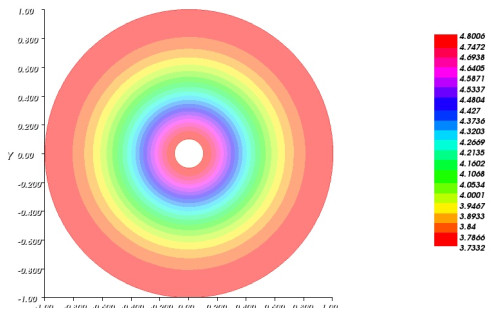









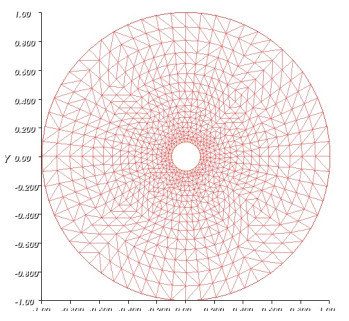
 DownLoad:
DownLoad:
